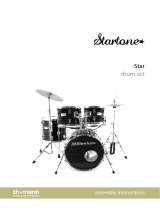
4
EAD10 Owner’s Manual
NOTICE
To avoid the possibility of malfunction/ damage to the product, damage
to data, or damage to other property, follow the notices below.
Handling
• Do not use the instrument in the vicinity of a TV, radio, stereo equip-
ment, mobile phone, or other electric devices. Otherwise, the
instrument, TV, or radio may generate noise. When you use the
instrument along with an application on your iPad, iPhone or iPod
touch, we recommend that you set “Airplane Mode” to “ON” on that
device in order to avoid noise caused by communication.
• Do not expose the instrument to excessive dust or vibrations, or
extreme cold or heat (such as in direct sunlight, near a heater, or in
a car during the day) to prevent the possibility of panel disfiguration,
damage to the internal components or unstable operation.
• Do not place vinyl, plastic or rubber objects on the instrument,
since this might discolor the panel or keyboard.
Maintenance
• When cleaning the instrument, use a soft and dry/slightly damp
cloth. Do not use paint thinners, solvents, alcohol, cleaning fluids,
or chemical-impregnated wiping cloths.
Saving data
• System settings (Reference Manual (Advanced)(PDF)) are stored
automatically and will not be lost when the power is turned off.
However, settings may be lost due to malfunction or improper oper-
ation. Save important data to an external device such as a USB
flash drive or a computer (pages 25 and 30). Please read page 30
before using a USB flash drive.
• Edits to Scenes, etc., are lost if not saved before the power is
turned off. Likewise, edits are lost when the auto power off function
turns the power off (page 29). Save data you want to keep to the
main unit, or to an external device such as a computer or USB flash
drive (pages 25 and 30). However, data stored in the main unit may
be lost due to malfunction or improper operation. Save important
data to an external device such as a USB flash drive or a computer
(pages 25 and 30). Please read page 30 before using a USB flash
drive.
• To protect against data loss through USB flash drive damage, we
recommend that you save your important data onto spare USB
flash drive or an external device such as a computer as backup
data.
Information
About copyrights
• Copying of the commercially available musical data including but
not limited to MIDI data and/or audio data is strictly prohibited
except for your personal use.
• This product incorporates and bundles contents in which Yamaha
owns copyrights or with respect to which Yamaha has license to use
others’ copyrights. Due to copyright laws and other relevant laws,
you are NOT allowed to distribute media in which these contents
are saved or recorded and remain virtually the same or very similar
to those in the product.
* The contents described above include a computer program, Accompani-
ment Style data, MIDI data, WAV data, voice recording data, a score, score
data, etc.
* You are allowed to distribute medium in which your performance or music
production using these contents is recorded, and the permission of Yamaha
Corporation is not required in such cases.
About this manual
• The illustrations and LCD screens as shown in this manual are for
instructional purposes only, and may appear somewhat different
from those on your instrument.
• Windows is a registered trademark of Microsoft® Corporation in the
United States and other countries.
• MacOS, iPhone and iPad are trademarks of Apple Inc., registered
in the U.S. and other countries.
• The company names and product names in this manual are the
trademarks or registered trademarks of their respective companies.
• The names of buttons, terminals, and the like from the EAD10’s
front, rear and top panels are enclosed in [ ] (square brackets).
Latest Firmware Version
From time to time, Yamaha may update product firmware without
prior notice.
We recommend, therefore, that you check our web site (below) for
the latest version and keep your EAD10 firmware up to date.
http://download.yamaha.com/
The content of this Owner’s Manual applies to the newest version of
the firmware as of printing. Details regarding any functions added to
later versions will also be made available via the above web site.
About the Pads
Within this Owner’s Manual, the optional external pads that may be
connected to the EAD10 are referred to by model name. Please note
that these model names were up-to-date as of printing of this man-
ual.
Details regarding any subsequently released models will be made
available via the following web site.
http://download.yamaha.com/
* Yamaha Corporation reserves the right to modify this URL at any
time without prior notice.




















